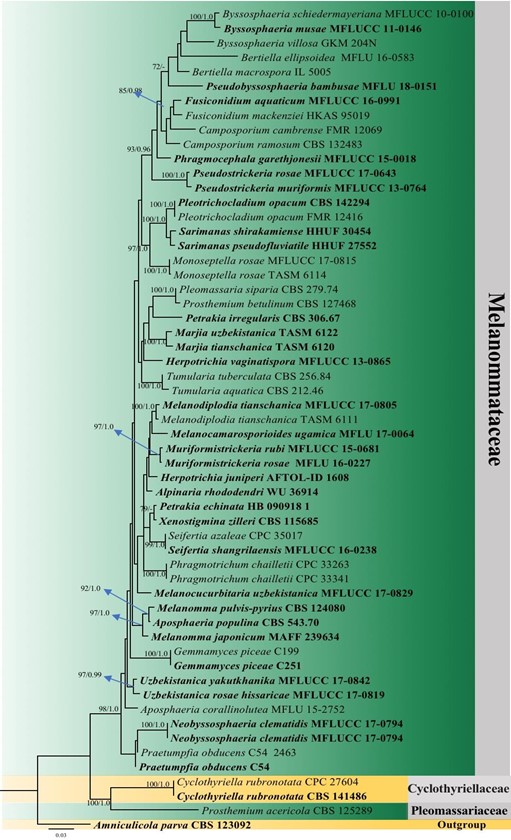Byssosphaeria Cooke, Grevillea 7(no. 43): 84 (1879).
MycoBank number: MB 711; Index Fungorum number: IF 711; Facesoffungi number: FoF 00765; 16 morphological species (Species Fungorum 2020), 9 species with molecular data.
Type species – Byssosphaeria keithii (Berk. & Broome) Cooke, Grevillea, Grevillea 7(no. 43): 84 (1879).
≡ Sphaeria keithii Berk. & Broome, Ann. Mag. nat. Hist., Ser. 4 17: 144 (1876).
Notes – Byssosphaeria comprises approximately 16 species (Species Fungorum 2020) but only nine species are published with detailed descriptions and molecular data, viz. B. jamaicana, B. macarangae, B. musae, B. rhodomphala, B. salebrosa, B. schiedermayeriana, B. siamensis, B. taiwanense, B. villosa. Byssosphaeria is a widespread genus distributed from temperate to tropical regions (Barr 1984, Chen & Hsieh 2004, Li & Zhuang 2008, Tian et al. 2015, Tennakoon et al. 2018a). Species in Pyrenochaeta or Chaetophoma-like have been reported as asexual morphs of Byssosphaeria (Tian et al. 2015, Wijayawardene et al. 2017a). Barr (1990a) formally described Byssosphaeria as it is characterized by superficial ascomata with bright yellow, orange or red flat apices around the ostiole, with dependant hyphal appendages that merge with the subiculum below and hyaline ascospores. Byssosphaeria has been assigned to Herpotrichia (Bose 1961, Sivanesan 1971, von Arx & Müller 1975), but it is distinguishable from Herpotrichia on account of the trabeculate pseudoparaphyses, as well as a subiculum (Hyde et al. 2000a). Mugambi & Huhndorf (2009a), Zhang et al. (2012b), Hyde et al. (2013), Tian et al. (2015), and this study (Fig. 109) confirmed the placement of Byssosphaeria in Melanommataceae with phylogenetic analysis.

Figure 109 – Phylogram generated from maximum likelihood analysis (RAxML) of genera in Melanommataceae based on ITS, LSU, and SSU sequence data. Maximum likelihood bootstrap values equal or above 70 %, Bayesian posterior probabilities equal or above 0.90 (MLBS/PP) are given at the nodes. An original isolate number is noted after the species name. The tree is rooted to Amniculicola parva (CBS 123092). The ex-type strains are indicated in bold. Hyphen (-) represents support values below 70 % MLBS and 0.90 PP.
Species
